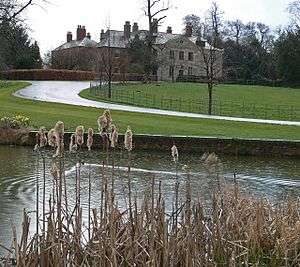Baggrave Hall
Baggrave Hall is an 18th-century Grade II* listed country house in the parish of Hungarton, Leicestershire, England.[1] It is a two and three-storey Palladian-style building constructed during the 1750s in ashlar, with a Swithland slate hipped roof and brick ridge chimney stacks. An additional wing in red brick can be dated to 1776. The current grounds of the hall cover 220 acres (0.89 km2). The hall was listed Grade II* in 1951, but suffered serious damage in 1988–1990.

History
Before the Dissolution of the Monasteries, the site belonged to Leicester Abbey.[2] It was then sold by the Crown to Francis Cave, whose grandson, Sir Alexander Cave, sold it on before 1625 to Edward Villiers, half-brother of the Duke of Buckingham.[3]
The hall belonged in the later 17th century to John Edwyn, whose grandson, also John, rebuilt it, but incorporated some parts of the 16th-century manor house.[1] In 1770, his daughter Anna Edwyn married Andrew Burnaby, archdeacon of Leicester, and so ownership of the estate passed to the Burnaby family. Later owners included Edwyn Burnaby, high sheriff of Leicestershire, his son Edwyn Burnaby, and his grandson Algernon Edwyn Burnaby. Baggrave Hall was the childhood-home of Louisa Burnaby, a great-grandmother of Elizabeth II. Soon after Algernon Burnaby's death in 1938,[4] his son and heir Hugh Edwyn Burnaby sold the estate.[5] It became the home of the Earle family, which sold it about 1975.[6]
The fabric of the building was severely damaged in 1988–1990 whilst in the ownership of an overseas company controlled by Asil Nadir, who had bought the estate for £3 million. Stonework was removed, walls undermined, and interior walls, floors and ceilings ruined. The current owner has undertaken to rectify the damage as far as possible.[7] The exterior of the house can be viewed close at hand from a public footpath that runs between South Croxton and Lowesby.
Legend
According to legend, the hall was named after an incident involving a maidservant. She is said to have let a beggar woman take refuge at the hall, but later noticed by the boots that this was a man in disguise. Fearing he was a robber, she murdered him and wrapped his body in a potato bag, in which he was buried.[8]
References
- "Baggrave Hall, Hungarton". British Listed Buildings. Retrieved 28 August 2012.
- "Baggrave Hall, South Croxton , England". Archived from the original on 23 December 2012. Retrieved 28 August 2012.
- Historic England. "Baggrave Hall (1000482)". National Heritage List for England. Retrieved 4 April 2015.
- BURNABY Algernon Edwyn in Probate Calendar for 1939 online
- Heather Broughton, Family and estate records in the Leicestershire Record Office (Leicestershire Museums, Art Galleries and Records Service, 1984), p. 7.
- Institute of Historic Building. Retrieved 24 June 2011.
- "BAGGRAVE HALL, LEICESTERSHIRE". Retrieved 28 August 2012.
- Ash, Russell (1973). Folklore, Myths and Legends of Britain. Reader's Digest Association Limited. p. 298. ISBN 9780340165973.